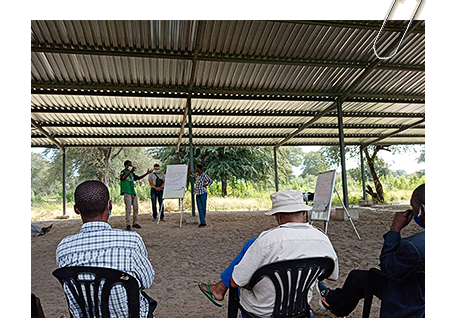The Khwe Traditional Knowledge Centre development in Bwabwata National Park
The Bwabwata National Park (BNP) situated along the north-eastern strip of Namibia is one of the few parks in southern Africa with communities permanently living inside a national park. The park was first proclaimed as the Caprivi Game Reserve in 1966, upgraded to the Caprivi Game Park in 1968 and finally the BNP was proclaimed in 2007. Prior to the area’s conservation status, the Khwe (or Khoé) tribe of the San people were the first inhabitants in the area, followed by the Bantu tribes in the late 18th century. This region of 6,274 km2 has always been an important traditional hunting and fishing area for the Khwe community and remain so to this day.A few years before the park’s official proclamation, the Khwe residents in the BNP formed the Kyaramacan Association (KA), an association modelled after the Community-Based Natural Resource Management (CBNRM) concept of conservancies. In Namibia, the CBRNM Policy enables rural communities to form and register conservancies for the purpose of sustainable utilisation of wildlife through tourism and game utilization. The KA was legalised in 2006 and is now made up of approximately 6000 BNP residents from various ethnic groups.
The KA represents all people living in the park on matters related to tourism development and the management and utilisation of natural resources within the BNP, in close collaboration with the Ministry of Environment, Forestry and Tourism (MEFT). This ensures co-management of natural resources between government and residents, for communities to generate benefits from their natural resources in a sustainable manner. The KA members currently benefit through the two most lucrative hunting concessions in the country, as well as a tourism concession.
In 2015 the KA expressed a desire to have a Traditional Knowledge Centre formally established in the BNP, to retain the traditional San knowledge and culture currently held by the elders of the community, and to transfer indigenous knowledge and skills to younger members of the Khwe community as well as the San communities across southern Africa. The idea was welcomed and supported by the MEFT, and the CBNRM-support organisation Integrated Rural Development and Nature Conservation (IRDNC), who are assisting the KA in acquiring funding from donors towards their centre’s planning and development.
The centre’s feasibility study was concluded in May 2021, funded by the Federal Republic of Germany through KFW Development Bank as part of the Namibian Parks Project’s Fourth Phase (NamParks IV) at the MEFT. Through a wider consultation with government partners and community members, the implementation plan was drafted for the Centre to include an information and reception area, amphitheatre, living museum, botanical garden, safari camps and accommodation for trainees. The aim of the Centre is mainly towards safeguarding traditional knowledge before it is lost from the older generations, to encourage the learning and application of new traditional practical skills, particularly amongst the younger generations of the Khwe communities, and at the same time demonstrate knowledge and skills to visitors through tracking tours and bush walks.
The training and education which will be provided will help the Khwe participants to discover talents, build confidence, increase employment, and generate a sense of pride amongst the KA community. It will introduce or re-introduce people to a particular way of living that links closely to the environment, living off the land in an eco-friendly low impact lifestyle. In this way, it will also help to educate and encourage visitors to promote sustainable use of resources, to live in harmony with the environment in a healthier and less consumer-driven manner.
“We want to preserve our culture. As any culture, without its language it can be lost. We want to pass on the knowledge to the younger generation since our elders are ageing now. This way the youth can gain skills that can be beneficial to us all. Above all, we want to promote our culture to tourists as it is our pride”, says Dikoshi Staphanus, KA’s Public Relation Officer.
This iconic centre will preserve and promote the preservation of the indigenous culture, memories and traditions of the San in the long term, in particular, for the Khwe community. It will educate and train communities to become self-reliant, self-employed and generate an income from tourism activities, craft sales to tourists and visitors to the heritage centre, and small spin-off businesses such as vegetable gardens to provide food for the centre and residents.
The Khwe Traditional Knowledge Centre will be a place where the Khwe can tell their story, demonstrate their lifestyles at a living museum and keep their memories alive. It will be a combination of retention of traditions through the living museum and sharing their heritage with fee-paying visitors through live performances, souvenirs and celebrations, which makes a sustainable nature-based economy for the Park’s residents.

- Benson Kupinga (IRDNC facilitator) left, with an Architectural consultant carrying out a feasibility study with KA communities on the Traditional Knowledge Project, Bwabwata National Park, Namibia



